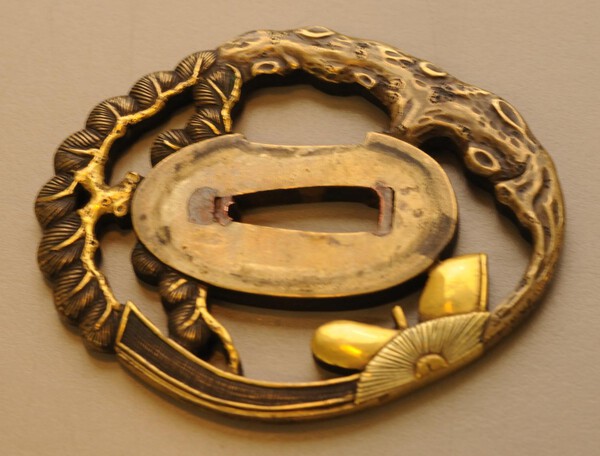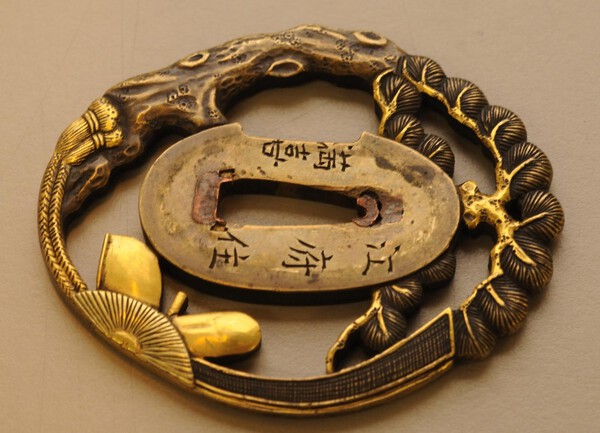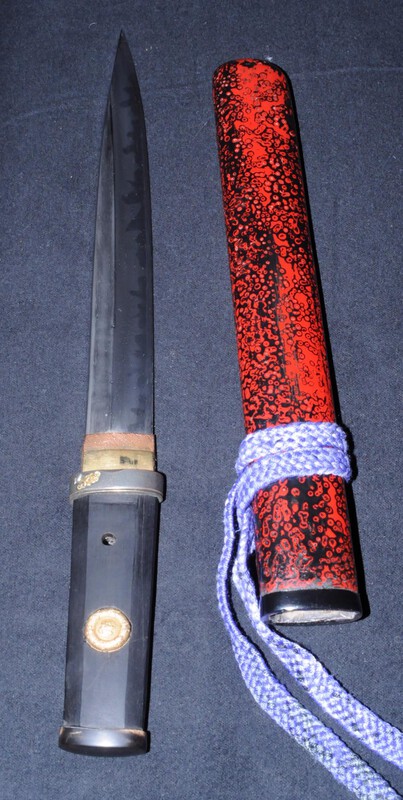
jct3602
Members-
Posts
171 -
Joined
-
Last visited
Everything posted by jct3602
-
Thanks George - I read it the same; also the apparent date is something like 15th year, and in the koto period most of the reigns that were that length or more were in the 16th century. About 5 years ago at the Burlingame token kai a top flight polisher, Jimmy Hayashi, said his opinion was Mino. Since then i have cleaned it up a great deal more, and am interested in what he thinks about it when i take it to the show in August. Thank you all for your ideas and help. john twineham
-
Hi - my thanks for all the assistance and information! The kuni character that I am trying to figure is on a 56.7cm tachi mei wak, which was shortened to that size; probably started perhaps around 62cm. Got it 10 years ago as a mass of rust for cleaning practice; it was interesting having a very shallow marumune and significant curvature; slowly have cleaned it up over the years and will submit it to the next Burlingame Shinsa, The placement of the kuni character is at the same position as the 1st character of the reign year on the opposite side (almost filed away, but appears to be "10"), so I believe the kuni is not part of the smith's name but the 3rd character in a province designation, with the 1st 2 characters filed away, as were the 2 characters of the Imperial on the date side. The kuni has what looks like a big "J" in the middle of the box with 2 smaller j's one on top of the other to its right (including an attatched picture); if anyone has seen a similar construction for kuni and remembers the source I would appreciate the info. The other possibility is of courses that the smith was illiterate and basically trying to copy something that a priest or other literate person had set down and just made a bad job of it. Thanks, John T
-
Question for translations - Hawley lists something in excess of 20 different ways to inscribe "kuni". Besides the preferences and quirks of individual smiths, would the way "kuni" character is presented be linkable to a particular school/town/province. For instance, would a smith from Osafune generally use one particular form of kuni and smiths from Seki typically use another? Might be useful in deciphering mei where part of the signature was obliterated by suriage or machi-okuri, with the 1st visible kanji being kuni and the two higher kanji with the province name being wiped away by filing. John T
-
My thanks for the assistance! John Twineham
-
-
-
my worst purchase was not in swords but is the computer I am using right now. Bought it as a back up from Fry's electronics in Palo Alto, Ca about 1 1/2 years ago. Checked that it got on the internet and did not use it till my good computer broke down. It is a low end Hewlett -Packard with Vista on it; try to view an article from Yahoo, and it takes 2 minutes to download; visual stuff starts and stops like an 80's computer. Type an email and it hangs up every 4th letter. HP loaded it up with more programs than it had the RAM to easily handle; have dumped those I could, but many are put in as read only, so it is still a snail. Tempted to go into Fry's when I visit California and just dump it in the middle of the floor. Was fooled by the great high end HP monitor I have, the w2558hc. Well, hopefully I have learned a lesson...... john T.
-
An old Xerox of the oshigata of a sword my father sold back to Japan in the early 60's. A real Inoue Shinkai mei? Also interested in the translation of rest of paper (done in Japan between 1945 and 1951), but will add it later. Thanks, John T.
-
Hi Marius - Do you remember the nature of the arc? Was it a fairly flat curve or higher. The reason I am curious is one of my first blades from is marumune, the height of the curve at the munemachi is around 1.2mm and the width of the mune is just under 5mm, so about a 1:4 ratio. Thanks, john
-
Some questions - Do some of you have marumune tachi or katana in your collections, what period/schools/makers are they thought to be if you have any information on them? How steep is the curvature - that is, almost flat, rounded with max height about 1/2 the width of the mune (a circular radius), or a higher rounded oval? I know this style is uncommon, so would appreciate any info. thanks, john
-
-
Hi Brian The upper portion of the blade was not altered; just ended up with the top 40% of a katana or a tachi after o-suriage. Was a shame that whoever unloaded the blade to the dealer I got it from broke it so badly; was around 65cm originally. As a salvage job, I commissioned the work but beyond that just occasional input when my opinion was requested on things like color of sageo, upgrades on fuchi and menuki, etc (really not much). My friend cut the blade down, did the lacquer work, made the habaki (made 7 habaki on one before he was happy with the result) and tsuka. The thunder god menuki were from his collection; the round gold mon menuki were from mine. The fuchi for the aikuchi were 3/4 from his collection; he made the lower piece in the mouth of the satsuma-age and the pommel cap. The elephant god mount on the sageo holder was also his. Obviously difficult work sculpting the satsuma-age since some of the metal to be removed was tempered; tapering the blade from the mune into large midare in the ha to get a tempered tip, and taking a little metal off the end of the ha to balance it was tough. He would do a portion, then something else would not look good enough, so the pieces went through round after round of upgrades (all to the better). Anyway, the lacquer work is excellent (he does restoration of writing boxes, etc. for a prominent museum on occasion) and also does professional work on tsuka; everything else very good. I have done a lot of uchiko work in the 3 months since I got them back, just to see some details, but they both need an appropriate polish at some point. Anyway, was about an 8 year project, starting with a blade that 2 dealers said to throw in the nearest trashcan, lol. john
-
-
-
Ken, thanks for the reply - just wondering if anyone had an opinion on school, etc. My personal is early Shinto Bizen style or Sue-Koto Bizen. I do know lots of schools have gasaku works with dissimilar hamon and/or boshi. Always appreciate any suggestions - they all help research. john
-
Background - came upon a blade which had been virtually snapped in two; you could see light through the crack at the shinogi. Had a friend do an o-suriage on the front half and a satsuma-age on the lower. Original length was about 67cm; the resultant blades are 26.5 cm for the suriage and 22.5 cm for the satsuma-age. Would like any ideas about the hamon. The pictures is the base of one side of the the o-suriage. The last two are the base of both sidse of the satsuma-age. the two sides have different hamons, and appear to have different boshi also. These were all taken with cellphone, so obviously not good quality pictures. Have plenty more shots, including the tip portion and configuration of the Satsuma-age (very interesting). The lower half of the original blade is showing midare utsuri on the left side with edge down, may be able to make it out in picture 2, but still faint and always hard to photo. Original - sakihaba 1.75 cm; motohaba 2.80 cm, was mumei when I came upon it. Probably previously shortened; had a high koshi sori which allowed the Satsuma-age to taper into some large hardened formations, thus giving it the necessary tempered tip. I think originally that the high koshi sori was torii sori before the earlier suriage, but who knows. Still can not say much about the hada and jigane; looks like mokume or small itame, but I would not bet my money taking a guess of any kind. Hope someone finds this interesting, john
-
If anyone would like the higher resolution images, I can e-mail them - the compression appears to occur in saving it from the e-mail to a computer file. john
-
Sorry to all about the lack of quality of the pictures - they automatically downsized from 2.3 MB to 80 KB when I took them from my cell to my computer. Obviously loosing 30x of detail makes it very hard to see some of the important fine points. john
-
-
Curran, the NTHK Kanteisho was from the 2010 San Francisco Shinsa - characteristics were shakudo, nanako, gold metal, carved inlay (suemon). attribution was mid Edo Kyo Kinko. There was a description of the design in Kanji, but I could not read it. Dimensions - height 1.22 cm, width 3.72 cm. thanks, john
-
My thanks to both Curran and nagamaki for your assistance. I will post pictures of the fuchi I have questions about as soon as I can get it off an old computer and on to a newer one (the DVD drive is dead and I have to find CDs to use the writer on the CD drive). The file is a bitmap and is 6.63 MB with no room for cropping, so I believe I will have to divide it into 2 pictures to get under the size requirements. The fuchi is about 1.2 cm high, with a background of shakudo nanako. the motif I have been told is birds seen through a teahouse window - gold birds and what looks like an old country fence also in gold. both rims are gold, each about 1 mm wide. The remaining 1 cm has 30 lines of nanako (probably 32 with covering from the gold edging); the pattern is not consistent; seems to be a mix of pattern A and B. Grain is not easily visible even with magnifying glass, but the 6.63mb bitmap blows it up to fill a full 25.5 inch diagonal screen, where everything is much easier to see. Thanks again, John
-
On all but one of the fuchi with nanako I have seen (admittedly not very many), the pattern of rows of nanako appear to be offset on adjacent lines (to fit the rows in tighter and/or make construction easier?). However, in that one fuchi, the nanako make a square pattern, with the dots aligned in rows both horizontally and vertically. It also is a good quality fuchi, having papered NTHK kanteisho. This leads to my questions - Is this nanako formation common, uncommon, or rare? If it is rare, is it indicative of any particular school or maker? Just interested in info or opinions anyone might have. My thanks in advance, john
-
Earliest Date On A Kogarasu Maru Blade?
jct3602 replied to jct3602's topic in Military Swords of Japan
Stephen, do you know what the armory numbering indicated, by any chance? looking at the armory blade in the kogarasu-maru style on page 180, it says #5-169. Now it is hard to believe at that point there were 169 generals in the Japanese army, much less 169 in the 5th series produced, so that numbering must mean something else. Does someone out there know? Also, from a personal point of interest, is there any significance to the lack of an armory number on the blade I have? john -
Earliest Date On A Kogarasu Maru Blade?
jct3602 replied to jct3602's topic in Military Swords of Japan
My thanks, Stephen and Cisco! The oshigata in Slough's book are very clear; obviously the seminal piece for the kogarasumaru style general's sword. Also the signature is different - the piece in Slough is signed Murata Tsuneyoshi; mine is signed Sho-Uju Kanemasa. Still an early piece with no armory production number and tempered, but almost 2 years younger than the prototype. Next question was the type of steel; Ohmura says Solingen steel was used in some of the early trials as was a mixture of Swedish and Japanese steel - this is one I feel will go unanswered unless my friend Michael Bell the swordsmith can give me a strong opinion. Once again, thank you all john -
Earliest Date On A Kogarasu Maru Blade?
jct3602 replied to jct3602's topic in Military Swords of Japan
Stephen, thank you. my email is jct3602@gmail.com. yours, John















